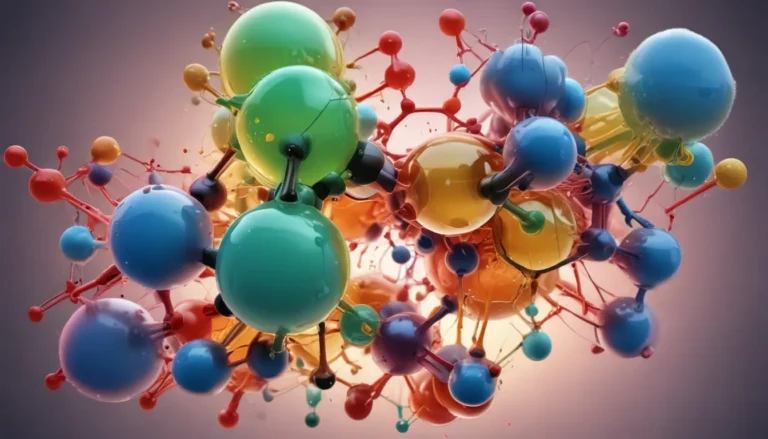A Note About Images: The images used in our articles are for illustration purposes only and may not exactly match the content. They are meant to engage readers, but the text should be relied upon for accurate information.
Are you ready to embark on a journey into the captivating world of equilibrium? Equilibrium is not just a static state in chemistry; it is a dynamic process that underpins the behavior of chemical reactions and the properties of matter. From pharmaceuticals to environmental science, equilibrium is a fundamental concept that impacts various fields. In this article, we will delve into 20 intriguing facts about equilibrium that will deepen your understanding and appreciation of this essential concept. Let’s unravel the mysteries of equilibrium together!
Understanding Equilibrium: A Balancing Act in Chemistry
Equilibrium is like a seesaw in chemistry, where the rates of forward and reverse reactions are balanced. It’s a delicate dance where the partners move at the same speed, maintaining a state of balance and stability in a chemical system. The concept of equilibrium, first established by the Belgian chemist Henri-Louis Le Chatelier in the late 19th century, has revolutionized our understanding of chemical reactions.
The Core Principles of Equilibrium
Le Chatelier’s Principle
Le Chatelier’s Principle is a cornerstone of equilibrium, stating that if a system at equilibrium is subjected to a change in conditions, it will respond to minimize the effect of the change. This principle guides how equilibrium systems adjust to external stimuli to maintain their balanced state.
Dynamic Equilibrium
In a dynamic equilibrium, the concentrations of reactants and products remain constant over time, even though reactions are continuously occurring. This dynamic interplay between molecules ensures a state of balance in the system.
Exploring the Dimensions of Equilibrium
Equilibrium Constant (K)
The equilibrium constant, denoted as K, is a quantitative measure of the position of equilibrium. It is calculated by comparing the concentrations of products and reactants at equilibrium, providing valuable insights into the equilibrium position.
Reversible Reactions
Equilibrium is commonly observed in reversible reactions, where reactants can form products, and products can also react to form reactants. This dynamic interchange between reactants and products maintains the equilibrium state.
Factors Influencing Equilibrium
Effect of Temperature
Changes in temperature can impact the position of equilibrium. According to Le Chatelier’s Principle, increasing the temperature of an exothermic reaction will shift the equilibrium towards the reactants, while increasing the temperature of an endothermic reaction will favor the products.
Effect of Pressure
For reactions involving gases, changes in pressure can influence the equilibrium position. An increase in pressure will favor the side with fewer moles of gas, while a decrease in pressure will favor the side with more moles of gas.
Effect of Concentration
The concentration of reactants and products can alter the equilibrium position. Adding more reactants or products will shift the equilibrium to favor the opposite side, while removing reactants or products will shift the equilibrium towards the side with fewer molecules.
Applications of Equilibrium
Equilibrium in Chemical Reactions
Chemical reactions reach equilibrium under specific conditions, such as a closed system and sufficient time for the forward and reverse reactions to balance. Understanding equilibrium is crucial for predicting the behavior of chemical systems.
Equilibrium in Biological Systems
In biological systems, equilibrium plays a vital role in enzyme-catalyzed reactions, where the balance between substrate and product concentrations determines the overall reaction rate. Equilibrium is essential for maintaining biological processes.
Equilibrium in Physical Processes
Equilibrium is observed in physical processes, such as the equilibrium between liquid and vapor phases in a closed container. This dynamic balance between phases is essential for understanding physical properties.
Exploring Equilibrium in Depth
Equilibrium and Solubility
The solubility of a solute in a solvent depends on the dynamic equilibrium established between dissolved and undissolved particles. Understanding solubility equilibria is crucial in various chemical processes.
Equilibrium and Acid-Base Reactions
Acid-base reactions reach equilibrium when the concentrations of reactants and products stabilize, resulting in a stable pH. The equilibrium in acid-base systems influences the strength of acids and bases.
Equilibrium in Electrochemical Cells
Electrochemical cells, such as batteries, operate based on the principle of equilibrium between oxidation and reduction reactions. Equilibrium in electrochemical systems is essential for generating and storing energy.
Unveiling the Power of Equilibrium
Equilibrium is not just a concept in chemistry; it is a fundamental principle that governs the behavior of chemical and physical processes. Whether in reversible reactions, acid-base equilibria, or industrial processes, equilibrium serves as a cornerstone in the world of science. By understanding the factors that influence equilibrium and the principles that guide its behavior, we can unlock new possibilities and make significant advancements in various fields.
Delving Deeper into Equilibrium
Are you ready to explore the captivating world of equilibrium further? Dive into the mesmerizing intricacies of dynamic equilibrium, unravel the enigmatic secrets of reaction quotients, and immerse yourself in the enthralling depths of chemical equilibrium. Quench your thirst for knowledge with these tantalizing articles that will leave you craving more insights into the multifaceted world of equilibrium.
Embracing Quality Content
At the core of our mission is the commitment to delivering trustworthy and engaging content. Each fact shared on our platform is contributed by real users like you, bringing a diverse range of insights and information. Our dedicated editors ensure the highest standards of accuracy and reliability by meticulously reviewing each submission. Trust in our commitment to quality and authenticity as you embark on a journey of exploration and learning with us.
Frequently Asked Questions
Q: What is equilibrium in chemistry?
A: Equilibrium in chemistry refers to a state where the rate of the forward reaction equals the rate of the reverse reaction. It signifies a balance where there is no further net change in the concentrations of reactants and products.
Q: How is equilibrium achieved?
A: Equilibrium is achieved when the rates of the forward and reverse reactions become equal. This balance can be attained by adjusting factors such as temperature, pressure, and concentration to favor the desired reaction.
Q: What are the types of equilibrium?
A: There are three types of equilibrium: static equilibrium, where there is no change in position; mechanical equilibrium, where there is no change in velocity; and chemical equilibrium, where the concentrations of reactants and products remain constant over time.
Q: How does equilibrium relate to Le Chatelier’s principle?
A: Le Chatelier’s principle dictates that if a system at equilibrium experiences a change in temperature, pressure, or concentration, it will respond to counteract the change. Adjustments are made to restore equilibrium in response to external alterations.
Q: Can equilibrium be disrupted?
A: Equilibrium can be disrupted by altering conditions such as temperature, pressure, or concentration. These changes prompt the system to readjust to a new equilibrium position to maintain a balance between the forward and reverse reactions.
Embark on a Journey of Discovery with Equilibrium
Equilibrium is a captivating concept that opens doors to a myriad of possibilities in the realms of science and discovery. By unraveling the mysteries of equilibrium and delving into its intricate workings, we gain valuable insights that empower us to make groundbreaking advancements in various fields. Embrace the transformative power of equilibrium and embark on a journey of discovery, where each revelation brings us closer to unlocking the secrets of the universe.






